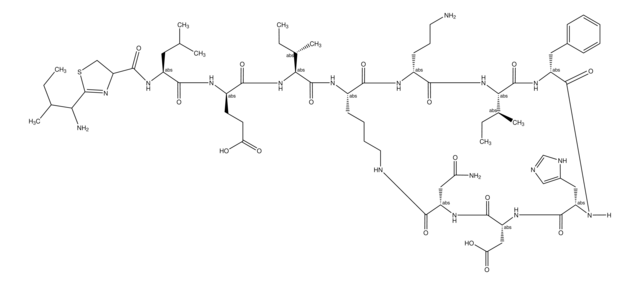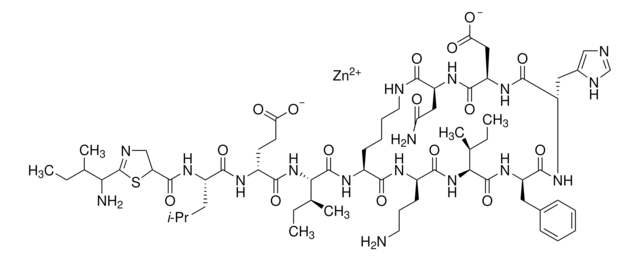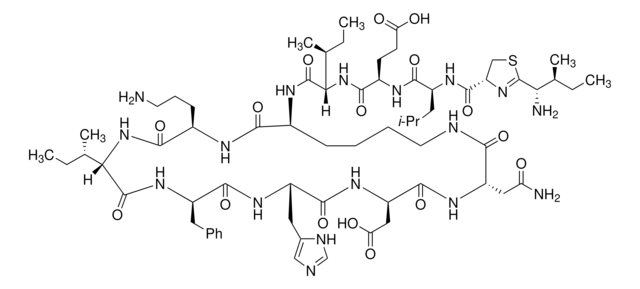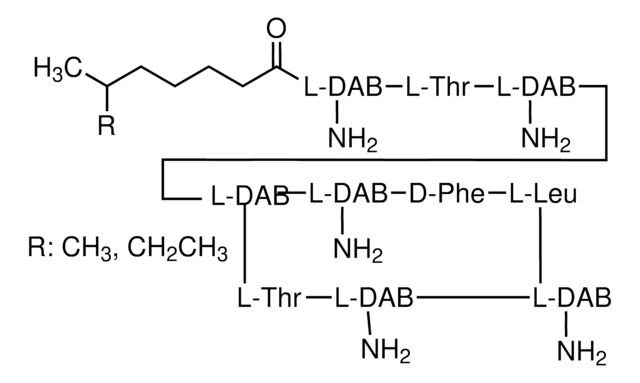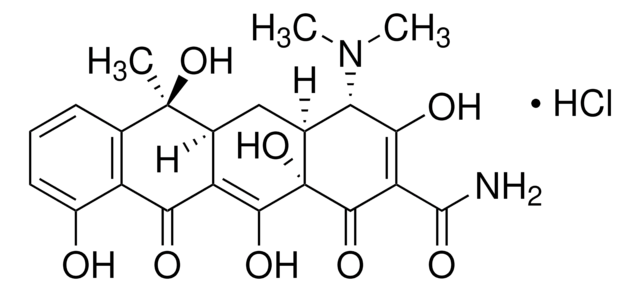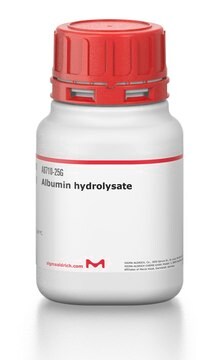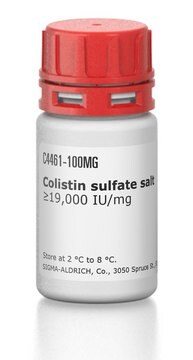Wichtige Dokumente
B5150
Bacitracin Zinksalz
from Bacillus licheniformis, ~70,000 U/g
Synonym(e):
Zinc bacitracin
About This Item
Empfohlene Produkte
Biologische Quelle
Bacillus licheniformis
Form
powder
Spezifische Aktivität
~70,000 U/g
mp (Schmelzpunkt)
250 °C (dec.) (lit.)
Wirkungsspektrum von Antibiotika
Gram-positive bacteria
Wirkungsweise
cell wall synthesis | interferes
Lagertemp.
2-8°C
SMILES String
[Zn++].CCC(C)C(N)C1=NCC(S1)C(=O)N[C@@H](CC(C)C)C(=O)N[C@H](CCC([O-])=O)C(=O)N[C@@H]([C@@H](C)CC)C(=O)N[C@H]2CCCCNC(=O)[C@H](CC(N)=O)NC(=O)[C@@H](CC([O-])=O)NC(=O)[C@H](Cc3cnc[nH]3)NC(=O)[C@@H](Cc4ccccc4)NC(=O)[C@@H](NC(=O)[C@@H](CCCN)NC2=O)[C@@H](C)CC
InChI
1S/C66H103N17O16S.Zn/c1-9-35(6)52(69)66-72-32-48(100-66)63(97)80-43(26-34(4)5)59(93)75-42(22-23-50(85)86)58(92)83-53(36(7)10-2)64(98)76-40-20-15-16-25-71-55(89)46(29-49(68)84)78-62(96)47(30-51(87)88)79-61(95)45(28-39-31-70-33-73-39)77-60(94)44(27-38-18-13-12-14-19-38)81-65(99)54(37(8)11-3)82-57(91)41(21-17-24-67)74-56(40)90;/h12-14,18-19,31,33-37,40-48,52-54H,9-11,15-17,20-30,32,67,69H2,1-8H3,(H2,68,84)(H,70,73)(H,71,89)(H,74,90)(H,75,93)(H,76,98)(H,77,94)(H,78,96)(H,79,95)(H,80,97)(H,81,99)(H,82,91)(H,83,92)(H,85,86)(H,87,88);/q;+2/p-2/t35?,36-,37-,40-,41+,42+,43-,44+,45-,46-,47+,48?,52?,53-,54-;/m0./s1
InChIKey
NKULICGUDKGGRL-FCHFGNCGSA-L
Suchen Sie nach ähnlichen Produkten? Aufrufen Leitfaden zum Produktvergleich
Allgemeine Beschreibung
Anwendung
Biochem./physiol. Wirkung
Mode of Action: Inhibits bacterial cell wall synthesis by inhibiting dephosphorylation of lipid pyrophosphate.
Sonstige Hinweise
Lagerklassenschlüssel
11 - Combustible Solids
WGK
WGK 3
Flammpunkt (°F)
Not applicable
Flammpunkt (°C)
Not applicable
Persönliche Schutzausrüstung
Eyeshields, Gloves, type N95 (US)
Hier finden Sie alle aktuellen Versionen:
Besitzen Sie dieses Produkt bereits?
In der Dokumentenbibliothek finden Sie die Dokumentation zu den Produkten, die Sie kürzlich erworben haben.
Kunden haben sich ebenfalls angesehen
Unser Team von Wissenschaftlern verfügt über Erfahrung in allen Forschungsbereichen einschließlich Life Science, Materialwissenschaften, chemischer Synthese, Chromatographie, Analytik und vielen mehr..
Setzen Sie sich mit dem technischen Dienst in Verbindung.